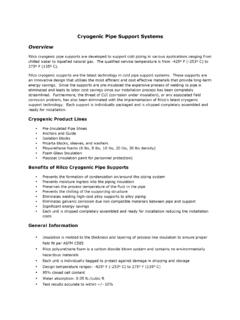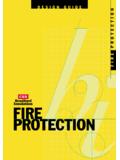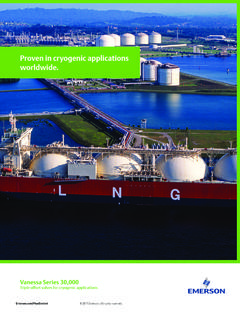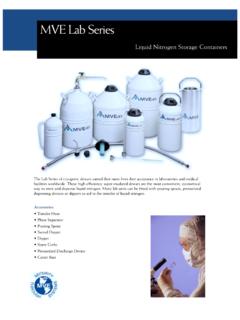Transcription of A review of concrete properties at cryogenic …
1 A review of concrete properties at cryogenic temperatures : towards direct LNG containment Reginald B. Kogbara1, Srinath R. Iyengar1, Zachary C. Grasley2,3, Eyad A. Masad1,2, Dan G. Zollinger2 1 Mechanical Engineering Program, Texas A&M University at Qatar, Box 23874, Education City, Doha, Qatar. 2 Zachry Department of Civil Engineering, Texas A&M University, College Station, TX 77843, USA. 3 The Charles E. Via, Jr. Department of Civil and Environmental Engineering, Virginia Polytechnic Institute and State University, Blacksburg, VA 24061, USA. Abstract This paper provides a state-of-the-art review of the pertinent properties of concrete at temperatures lower than -165 C that make it amenable for direct containment of liquefied natural gas (LNG). In addition, the paper presents a brief historical and economic perspective on cryogenic concrete . The permeability, coefficient of thermal expansion (CTE), tensile strain capacity and bond strength to reinforcement are discussed in light of key factors controlling them, including moisture content, aggregate type, etc.
2 Moreover, the effects of cryogenic freeze-thaw cycles on thermal deformation of concrete are highlighted. Generally, the permeability and the CTE are lower while the tensile strain capacity and bond strength to reinforcement are greater for concrete at cryogenic temperatures versus concrete at ambient temperatures . It is concluded that more work is necessary to fully understand thermal dilation and damage growth in concrete due to differential CTE of its components, in order to facilitate development of design methodologies that might be employed to mitigate the associated risks in its eventual utilization for direct LNG containment. This is an author-created version: (RB Kogbara). A definitive version was subsequently published at in Construction and Building Materials, Volume 47, Pages 767 770 (2013). The final publication is available at Research highlights This is a state-of-the-art review of concrete properties at cryogenic temperatures .
3 The properties pertinent for direct LNG containment are identified and discussed. The moisture content generally determines the extent of variation of the properties . The effects of cryogenic freeze-thaw cycles on concrete deformation are highlighted. Some ways to improve concrete durability for cryogenic storage of LNG are suggested. 1 A review of concrete properties at cryogenic temperatures : towards direct LNG containment Reginald B. Kogbara1*, Srinath R. Iyengar1, Zachary C. Grasley2,3, Eyad A. Masad1,2, Dan G. Zollinger2 1 Mechanical Engineering Program, Texas A&M University at Qatar, Box 23874, Education City, Doha, Qatar. 2 Zachry Department of Civil Engineering, Texas A&M University, College Station, TX 77843, USA. 3 The Charles E. Via, Jr. Department of Civil and Environmental Engineering, Virginia Polytechnic Institute and State University, Blacksburg, VA 24061, USA. Abstract This paper provides a state-of-the-art review of the pertinent properties of concrete at temperatures lower than -165 C that make it amenable for direct containment of liquefied natural gas (LNG).
4 In addition, the paper presents a brief historical and economic perspective on cryogenic concrete . The permeability, coefficient of thermal expansion (CTE), tensile strain capacity and bond strength to reinforcement are discussed in light of key factors controlling them, including moisture content, aggregate type, etc. Moreover, the effects of cryogenic freeze-thaw cycles on thermal deformation of concrete are highlighted. Generally, the permeability and the CTE are lower while the tensile strain capacity and bond strength to reinforcement are greater for concrete at cryogenic temperatures versus concrete at ambient temperatures . It is concluded that more work is necessary to fully understand thermal dilation and damage growth in concrete due to differential CTE of its components, in order to facilitate development of * Corresponding author email: Tel: +974 4423 0289.
5 2 design methodologies that might be employed to mitigate the associated risks in its eventual utilization for direct LNG containment. Keywords: Cracking; liquefied natural gas; permeability; tensile strain; thermal dilation. 1. Introduction concrete is the most widely used construction material in the world. Its properties at room, ambient and elevated temperatures are well documented - see, [1-4]. However, concrete behavior at cryogenic temperatures ( temperatures lower than -165 C) is not fully elucidated. The majority of current liquefied natural gas (LNG) storage tanks, especially in Qatar, utilize 9% nickel steel walls as the primary containment tank due to its greater ductility at cryogenic temperatures compared to normal carbon steel. With the development of the ACI 376-10 code [5] on concrete structures for containment of refrigerated liquefied gases, there may be increasing impetus for tank designs utilizing concrete for primary containment of LNG, which would substantially reduce construction costs.
6 Therefore, a fundamental understanding of the behavior of concrete as it is cooled to cryogenic temperatures is necessary to enhance safety and long-term durability of an all- concrete LNG storage tank. These efforts to understand cryogenic concrete would focus on the mechanism governing thermal dilation and damage growth due to differential coefficient of thermal expansion (CTE) of its components. Previous research on the properties of concrete at cryogenic temperatures summarized by Krstulovic-Opara [6], which is directly cited in the ACI 376-10 code, show that concrete properties at cryogenic temperatures differ from known behavior at room temperature. The 3 aforementioned work provided a thorough review of the effect of cryogenic temperatures on mechanical and thermal properties of concrete . The work also provided details on the mechanism of water freezing and frost damage, the effect of pore sizes on freezing, and the interaction between freezing water and concrete .
7 The Wiedemann pore model [7], which explains the impact of the above factors on the overall effect of water freezing, and identifies the behavior of freezing water in nine distinct temperature ranges, was also elucidated. However, the effect of bond strength to reinforcement and thermal cycling was not dealt with as the work focused on concrete exposed to a single freezing cycle. Therefore, this paper builds on the work of Krstulovic-Opara [6] and fills in the gaps in the literature as well as documenting newer developments in the field since the last review was published. Beginning with a brief historical and economic perspective on concrete tanks, and a background on ice formation in concrete , this paper focuses on the pertinent properties influencing the design of cryogenic concrete tanks and their controlling factors. The effects of thermal cycling on the pertinent concrete properties are also discussed.
8 2. Brief historical and economic perspective on cryogenic concrete tanks It has been reported that by 2004, nine tanks using post-tensioned reinforced concrete for the primary containment of LNG have been constructed. The oldest of these tanks has been in continuous service since 1969 [8]. The same tank system were also used for successful storage of liquid oxygen as it proved impervious to liquid oxygen with no metallic liner employed [9]. Figure 1 shows an illustration of a cryogenic tank made up of concrete only, with no metallic liner. Such tanks mainly have a monolithic joint between the primary container walls and slab, a secondary container made with concrete with a moisture vapor barrier applied, and a secondary 4 bottom ideally constructed from a non-metallic material such as MylarTM sandwich a poly(ethylene terephthalate) material with very low permeability suited for cryogenic temperatures [10].
9 A base insulation formed of weatherproofed blocks is also a major feature of such tanks. The expanded perlite insulation between the inner and outer tank wall (Figure 1) acts as a barrier to avoid the possibility of a single containment tank that would be exposed to a strong thermal gradient due to cryogenic temperature on one side and ambient temperature on the other. The secondary container and foundation settings are similar to the conventional 9% nickel steel tanks [8]. However, after expansion of the LNG industry slowed down in the 1980s, marketing efforts decreased leading to a halt in the production of concrete LNG tanks by Cryocrete Inc (then known as Preload) [8]. (Insert Figure 1 here) Construction of concrete -only tanks was found to be significantly cheaper than 9% nickel steel tanks using cost comparison from three countries as shown in Figure 2. In fact, it has been estimated that while the cost of conventional 9% nickel steel LNG storage tanks in 1999 was about US$400/m3, concrete -only storage tanks could cost about US$216/m3 [11].
10 Thus, there could be a substantial increase in cost savings when the concept of all- concrete tanks becomes established in the LNG market. Further, the ability to construct the primary and secondary containers in parallel using the slip forming technique shortens the construction schedule to around 24 months, compared to 33 36 months typical for 9% nickel steel tanks. Such construction techniques also lower operating costs at construction sites [8, 11]. (Insert Figure 2 here) 5 3. concrete properties pertinent for direct LNG containment Many properties of concrete improve at cryogenic temperatures [12]. Nevertheless, in the design of concrete for use in direct containment of LNG, certain performance criteria are of utmost importance. One such criterion is the permeability of concrete as it controls the rate by which LNG is lost from the primary container. The permeability of concrete to LNG at cryogenic temperatures is likely dominated by the presence of microcracks since most of the inherent porosity in concrete at cryogenic temperatures is blocked by ice formation [13].








